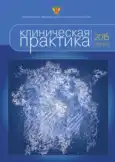EARLY BREAST CANCER. THE CONTROVERSY OF BREAST CANCER IN SITU
- Authors: Kosyi VV1, Kedrova AG1
-
Affiliations:
- ФНКЦ ФМБА России
- Issue: Vol 6, No 2 (2015)
- Pages: 60-65
- Section: Articles
- URL: https://journals.rcsi.science/clinpractice/article/view/8333
- DOI: https://doi.org/10.17816/clinpract6260-65
- ID: 8333
Cite item
Full Text
Abstract
Full Text
##article.viewOnOriginalSite##About the authors
V V Kosyi
ФНКЦ ФМБА Россииврач-онколог онкологического отделения ФНКЦ ФМБА
A G Kedrova
ФНКЦ ФМБА России
Email: kedrova.anna@gmail.com
д.м.н., профессор, зав. онкологическим отделением ФНКЦ ФМБА России
References
- Nekhlyudov L, Habel LA, Achacoso N, et al. Ten-year risk of diagnostic mammograms and invasive breast procedures after breast-conserving surgery for DCIS. J Natl Cancer Inst. 2012;104: 614-621
- Cancer facts and figures 2015. Breast Carcinoma In situ. 2015. Atlanta: American Cancer Society; 2015. pp.26-37
- Narod SA, Iqbal J, Giannakeas V, Sopik V, Sun P. Breast cancer mortality after a diagnosis of ductal carcinoma in situ [published online August 20, 2015]. JAMA Oncol. doi: 10.1001/jamaoncol.2015.2510.
- Cuzick J, Sestak I, Cawthorn S, et al; IBIS-I Investigators. Tamoxifen for prevention of breast cancer: extended long-term follow-up of the IBIS-I breast cancer prevention trial. Lancet Oncol. 2015;16(1):67-75.
- Morrow M., Schnitt Stuart J., Norton L. //Current management of lesions associated with an increased risk of breast cancer. Nat Rev Clin Oncol. 2015, 12, 237-8.
- Provenzano E, Hopper JL, Giles GG et al. Biological markers that predict clinical recurrence in ductal carcinoma in situ of the breast. Eur J Cancer 2003; 39: 622-30.
- Lari SA, Kuerer HM. Biological Markers in DCIS and Risk of Breast Recurrence: A Systematic Review. J Cancer 2011; 2: 232-261
- Solin L, Gray R, Baehner FL, Butler S et al. A prospective validation study of the DCIS score from ECOG E5194. Cancer Res 2011; 71: 41.
- Lee H.S. Use of Immunohistochemistry in the Diagnosis of Problematic Breast Lesions. J Clin Pathol. 2013;66(6):471-477.
- Barnes, A. Cramer, R. Johnson, K.Cheema, et al. Bundred Molecular phenotypes of DCIS predict overall and invasive recurrence. Ann Onc 2015 May 1; 26(5): 1019 -25.
- Esserman L., Yau C., Rethinking the Standard for Ductal Carcinoma In Situ Treatment. JAMA Oncol. 2015 DOI: 10,1001 / jamaoncol.2015.2607.
- Guillot E, Vaysse C, Goetgeluck J, Falcou M.C., Extensive pure ductal carcinoma in situ of the breast: identification of predictors of associated infiltrating carcinoma and lymph node metastasis before immediate reconstructive surgery. Breast. 2014 Apr;23(2):97-103. doi: 10.1016/j.breast.2013.12.002.
- American Cancer Society. Lifetime risk of developing or dying from cancer. Revised October 1, 2014. http://www.cancer.org/cancer/cancerbasics/lifetime-probability-of-developing-or-dying-from-cancer. Accessed June 25, 2015.
- Luo J, Cochrane BB, Wactawski-Wende J, Hunt JR, Ockene JK, Margolis KL. Effects of menopausal hormone therapy on ductal carcinoma in situ of the breast. Breast Cancer Res Treat. 2013;137: 915-925
- Margolese RG, Cecchini RS, Julian TB, et al. Primary results, NRG Oncology/NSABP B-35: a clinical trial of anastrozole (A) versus tamoxifen (tam) in postmenopausal patients with DCIS undergoing lumpectomy plus radiotherapy. Am Soc Clin Oncol. 2015;33(suppl):abstr LBA500
- Correa C, McGale P, Taylor C, et al. Overview of the randomized trials of radiotherapy in ductal carcinoma in situ of the breast. J Natl Cancer Inst Monogr. 2010;2010: 162-177.
- National Comprehensive Cancer Network. Breast Cancer (Version 3.2014 October,2014). Available from URL www.nccn.org/professionals/ physician_gls/pdf/breast.pdf
- Rakovitch E., Nofech-Mozes S., Hanna W., et.al. A population-based validation study of the DCIS Score predicting recurrence risk in individuals treated by breast-conserving surgery alone. Breast Cancer Research and Treatment, July 2015, Volume 152, Issue 2, pp 389-398.
- Darby SC, Ewertz M, McGale P, et al. Risk of ischemic heart disease in women after radiotherapy for breast cancer. N Engl J Med. 2013;368(11):987-98
- Hughes KS, Schnaper LA, Bellon JR, et al. Lumpectomy plus tamoxifen with or without irradiation in women age 70 years or older with early breast cancer: long-term follow-up of CALGB 9343. J Clin Oncol. 2013;31(19):2382-87.
- Gao X, Fisher SG, Emami B. Risk of second primary cancer in the contralateral breast in women treated for early-stage breast cancer: a population-based study. Int J Radiat Oncol Biol Phys. 2003;56: 1038-45.
- Saslow D, Boetes C, Burke W, et al. American Cancer Society guidelines for breast screening with MRI as an adjunct to mammography. CA Cancer J Clin. 2007;57: 75-89
- Tuttle TM, Jarosek S, Habermann EB, et al. Increasing rates of contralateral prophylactic mastectomy among patients with ductal carcinoma in situ. J Clin Oncol. 2009; 27: 1362-1367
- Pieri A, Harvey J, Bundred N. Pleomorphic lobular carcinoma in situ of the breast: Can the evidence guidepractice? World J of Clin Onco. 2014;5: 546-553
- Chuba PJ, Hamre MR, Yap J, et al. Bilateral risk for subsequent breast cancer after lobular carcinoma-in-situ: analysis of Surveillance, Epidemiology, and End Results data. J Clin Oncol. 2005;23: 5534-5541
- Portschy PR, Marmor S, Nzara R, Virnig BA, Tuttle TM. Trends in incidence and management of lobular carcinoma in situ: a populationbased analysis. Ann Surg Oncol. 2013;20: 3240-46.
- Saslow D, Boetes C, Burke W, et al. American Cancer Society guidelines for breast screening with MRI as an adjunct to mammography. CA Cancer J Clin. 2007;57: 75-89.
- Allred DC, Anderson SJ, Paik S, et al. Adjuvant tamoxifen reduces subsequent breast cancer in women with estrogen receptor-positive ductal carcinoma in situ: a study based on NSABP protocol B-24. J Clin Oncol. 2012;30: 1268-73.
Supplementary files






